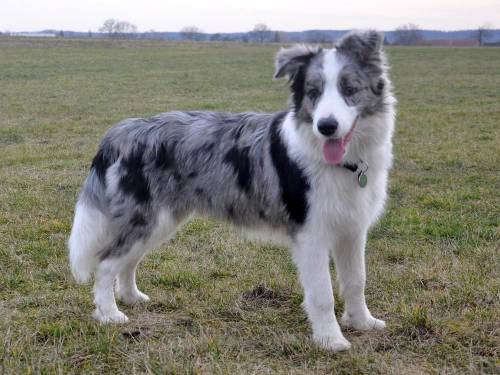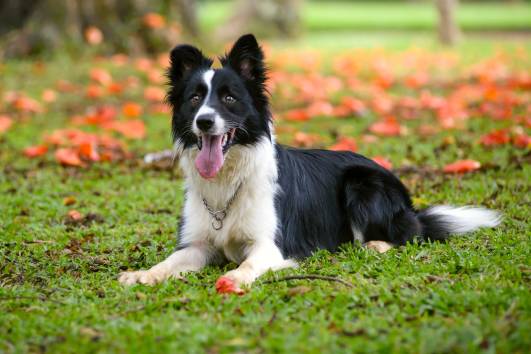Connect with a verified veterinarian in minutes. Licensed vets are available 24/7 to answer your questions. No need to worry about your furry family member.
Are you interested in adopting a blue merle Border Collie? Then you’ve come to the right place! We’ve put together some information about this dog breed to help you learn more about these wonderful dogs!
What is a Blue Merle Border Collie?
Before we get into the information about this dog breed, it’s important to understand the term “merle.” Merle describes the pattern in the dog’s fur rather than the color. The merle pattern is also seen in other dog breeds, not only the Blue Merle Border Collie.
First of all, Blue Merle Border Collies are often associated with Australian Shepherds, but they’re actually a separate breed. The Australian Shepherd, of course, is a very popular dog breed that was first bred in Australia. It’s known for its thick double coat and great personality.
Tricolor dogs were bred in Germany as a herding dog, but the Blue Merle Border Collie is a separate breed. The Australian Shepherd and the Blue Merle Border Collie are different breeds, but they’re often confused because of their similar appearance.
Sheepdogs have been a part of the Australian culture for thousands of years. The original sheepdogs were believed to be imported from England, but the first ones to arrive in Australia were from Scotland. Scottish sheepdogs were more sheep-friendly than the English dogs, and so they were brought to Australia.
One of the first breed of dogs to be registered in the AKC (American Kennel Club) was the White Border Collie. It is a very rare breed and almost never seen in the show ring. The reason for this is that there are two different color combinations, red and white. White Border Collies are usually born with a white base color, and some have the color of red or sable. The white can be spotted or clear, and the white markings are typically called “merle” markings. The White Border Collie is often confused with the Blue Merle Border Collie, but they are very different in their coloring.
The Slate Merle Border Collie is another rare breed that can be found in the show ring. They are similar to the Blue Merle Border Collie, but they have a lighter shade of gray.
The merle pattern is described as irregular, dark patches, smudges, or streaks of a lighter color than the base of the dog’s coat. When it comes to the Border Collies, they can come in various merle and coat color, including red merle, the double merle blue & white, blue merle, red & white merle, black & white merle, saddleback sable, sable merle dogs, and more. However, the Blue Merle Border Collie is one of the rarest colors in this breed.
In addition, splotches of blue and white are most common in the merle Border Collie. It is a genetic condition that causes merle, so there is no way to “reverse” it. When breeding two merles together, their puppies will usually be born with the same merle pattern as one of the parents.
Brindle is another pattern that can be seen in dogs of this breed. Brindle is a brown or red coat with a dark stripe down the back. Another variation of this breed is the Lilac Merle Border Collie. This dog is typically a solid lilac color, with a small blue or black merle. This particular dog breed is one of the rarest, but it is gaining popularity due to its unique look.
Non-merle Blue Merle Border Collies are often mistaken for the merle and often receive a lot of questions about their origin. Purebred Blue Merle Border Collies are a rare breed, and it is even rarer to find a Blue Merle Border Collie that has not been mated with a merle. The only way to be sure you have a purebred Blue Merle Border Collie is to see the FCI certificate of registration, which is usually available at the Border Collie Club of America website.
When breeders want to have blue merle puppies, then they must choose a parent who carries the merle gene. This makes the dark color (such as black) turn into a diluted color that’s a bit gray or blue, with swirls and streaks of color. What’s interesting is that the merle gene is dominant; however, the blue merle color pattern is very rare in Border Collies.
What’s more, a puppy Blue Merle Border Collie puppy may not produce blue merle puppies. There may be one merle puppy in the litter if that.
What’s Does a Blue Merle Border Collie Look Like?
A blue Merle Border Collie usually has a white chest with grey or blue fur. The blue-colored fur may have dark patches around the face & ears, the tail, and patches along the back. The coat type can be rough or smooth. These dogs are not categorized as hypoallergenic dogs.
These dogs can have brown eyes, amber eyes, light green eyes, blue eyes, or bi-colored eyes (one brown and one blue). It’s interesting to note that Blue Merle Border Collies with a saddle pattern usually have one blue eye and one merle eye (part brown and part blue).
Blue Merle Border collies usually have long tails, with short ears that can flop over or stand up straight.
These dogs have an average height between 18-22 inches and weigh between 30-55 lbs. Blue Merle Border Collies have an average lifespan expectancy of 10-17 years.

Review symptoms, medications & behavior to keep your pets healthy with a Vet Online in just minutes.
Ask a Vet Live NowCharacteristics & Temperament of Blue Merle Border Collies
he blue Merle Border Collie has the same temperament as regular Border Collies. These dogs are considered to be the best herding dogs in the world! They’re highly intelligent and filled to the brim with energy.
These dogs are eager to please and trainable; however, Blue Merle Border Collies are best for experienced pet parents. This is because the dogs can have a mind of their own and be a bit on the stubborn side. If you have a Blue Merle Border Collie, you can expect he may have some fun trying to outsmart you.
Border Collies, in general, are great with kids and other pets. However, they do have a strong herding instinct. For this reason, it’s best not to leave a Border Collie alone with kids or other pets. Otherwise, the dog may end up herding them around!
How Much Exercise Does a Blue Merle Border Collie Need?
A Blue Merle Border Collie will need a minimum of one-two hours of exercise a day. Remember, these are extremely active, agile working dogs. They have a ton of energy. To avoid unwanted behaviors, it’s best to ensure the dog receives plenty of exercise every day. You might consider a one-hour walk in the morning and another one-hour walk in the evening.
The activity level of the Blue Merle Border Collie will vary with the breed. They are more active when they are young and are usually not as active in their older years. You can expect a Border Collie to be quite energetic, as long as you provide them with enough exercise. Their energy levels are high, but their activity level is usually moderate.
Training a Blue Merle Border Collie
When it comes to training, a Border Collie will thrive on plenty of mental stimulation and challenges. Because they’re highly intelligent, these dogs will quickly become bored. A bored Border Collie may start to bark excessively, chewing up anything and everything in sight, and more. These dogs thrive when they have a challenge and work to do.
The good news is that Blue Merle Border Collies are extremely trainable. They’re also very sensitive and seem to understand what you want even before you give the cue! Plus, these dogs thrive on positive reinforcement training methods. You’ll find they’re eager to please, especially when you have some great treats on hand when you offer praise.
You may want to consider obedience training or agility/herding training for your dog. These dogs also love to run, flyball, fetch flying discs, freestyle obedience, and even tracking. He will be very happy to have the challenge and the fun these activities provide!
Blue Merle Border Collie Health
There are some health issues associated with Blue Merle Border Collies. They’re more susceptible to certain genetic health issues, including:
- Hip dysplasia
- Progressive renal atrophy
- Epilepsy
- Collie eye anomaly
- Neuronal ceroid lipofuscinosis
- Trapped neutrophil syndrome
Blue Merle Border Collies also seem to be more prone to deafness, especially if they have a white head, blue eyes, or a merle coat. A dog’s life expectancy is much shorter if it has a deafness problem.
If you’re interested in adopting a Blue Merle Border Collie, it’s important to make sure you’re adopting from a reputable breeder. This is the only way to ensure that your dog will have the health tests necessary to determine if it has any genetic health problems.
Grooming a Blue Merle Border Collie
When it comes to grooming, a Blue Merle Border Collie benefits from daily brushing, but it must be brushed at least twice a week. It’s necessary to brush them every day during shedding season (twice a year). These dogs may not need to be bathed more than once every couple of months.
These dogs are heavy shedders, especially during shedding season.
What’s the Cost of a Blue Merle Border Collie?
If you buy a Blue Merle Border Collie from a breeder, you may have to spend up to $4500 for a puppy. That’s because these dogs are extremely rare.
Is a Blue Merle Border Collie Right for You?
Blue Merle Border Collies, like all Border Collies, have a tendency to be barkers. This is because the dogs are highly intelligent and alert. However, this isn’t something that should cause any concerns for pet parents. The Border Collie is a friendly dog that enjoys being around people and other animals. If you want a friendly dog, this breed is perfect for you!
Blue Merle Border Collies are one of the smartest dogs in the world. This breed has been used as a police dog, drug detection dog, and as an assistance dog for the blind. Because of their intelligence and herding instincts, they make great family pets.
Blue Merle Border Collies are beautiful dogs; there’s no getting around that. They are unique and make excellent companions for active families. They do well with kids and other pets but should always be supervised due to their strong herding instincts.
Because of their strong herding instinct, Blue Merle Border Collies need daily exercise to burn off their energy. If they don’t get enough exercise they can become destructive. You should always supervise your Blue Merle Border Collie when he’s playing with toys or other things he shouldn’t be playing with. If you do not give your dog enough exercise he may develop problems with obsessive behaviors such as chewing on things or pulling on his leash when you walk him outside. So make sure you are giving your dog plenty of exercise! These dogs also require a ton of exercise because they’re filled with energy. They also do better with a job to do, which can include dog sports, competitions, or even helping around the house!
What’s more, they do tend to shed a lot. The Blue Merle Border Collie needs a lot of grooming. The dog’s coat is thick and requires a lot of brushing. If you don’t brush your dog’s coat, it will become tangled and matted. You should also check your dog’s ears for any signs of ear infections.
If you know how to deal with very smart, somewhat stubborn dogs and have space for a working dog, then you may want to consider a Blue Merle Collie!
Connect with a verified veterinarian in minutes. Licensed vets are available 24/7 to answer your questions. No need to worry about your furry family member.

Kim
Kim is a talented author, who loves animals especially dogs. She engaged in writing books and articles relating to animals a decade ago. Kim resides in Chicago with her husband and son. The family is the proud owner of a dog and a parrot (Jack and Lily). Kim wanted more than these two pets, but her husband put his foot down... She often visits elementary schools to talk to the kids about what she learned about pets and how they could learn from them.
Review symptoms, medications & behavior to keep your pets healthy with a Vet Online in just minutes.
Ask a Vet Live Now




